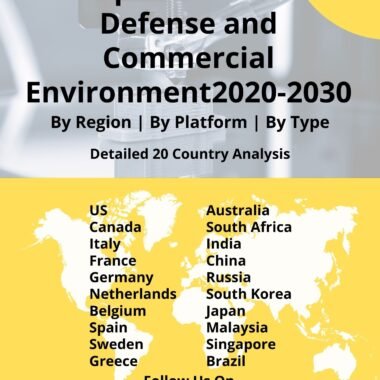Description
The tank and armored vehicle, as the army’s primary armament, have played an important role in battle from its creation. With the proliferation of smart anti-armor weaponry in recent years, tank and armored vehicles have faced all-round and three-dimensional threats on the ground and in the air, putting the crew’s survivability to the test like never before. In response to this circumstance, numerous countries have created tanks and armored vehicles with protection as the primary function.
As a revolutionary type of protection mechanism for tanks and armored vehicles, the active protection system is designed to detect approaching hostile targets ahead of time and confuse, intercept, or destroy them to avoid being struck. The active protection technology allows not only to raise the depth of protection but also to expand the protection space by integrating several additional protection technologies with minimal weight gain.
APS is classified into three types based on distinct protection mechanisms: aggressive, which is a soft-kill system; active, which is a hard-kill system; and a combination of the two. To achieve its own protection, the soft-kill APS uses “interference” and “camouflage” as the main tactical means, as well as detection alert and decoy jamming. The detection alert primarily detects the threat to the vehicle and issues an alarm signal using laser, infrared, or radar detection systems. After receiving the signal, the crew releases plumes of smoke and other means to interfere the incoming target. The Russian “Curtain-I” optoelectronic interference system, which forms an aerosol smoke screen to guard against semi-active laser-guided missiles and crosshair semi-auto guided missiles, is an example of a soft-kill system that uses detection warnings. The decoy jamming system interferes with the guiding system of anti-tank missiles with infrared and laser decoys in an attempt to cause them to divert from their intended flight trajectory, so ensuring their own protection.
At medium and close ranges, the hard-kill APS actively recognizes the oncoming target and constructs a counterattack defense system, that is, an active fire circle is built around the vehicle to intercept and destroy the incoming target before it impacts the vehicle. One or more sensors that can detect the threat, one computer and data processing device that can identify the threat and begin countermeasures, and one countermeasure device that can destroy or otherwise disable the threat comprise of the hard-kill APS.
During the 2006 Israel-Lebanon War, Israel was the first to experience the enhanced lethality of modern anti-armor weaponry, when its armoured formations were effectively brought to a halt by a few anti-tank guided missile teams camouflaged in the rocks of the Lebanese Bekaa Valley. During the 2014 Gaza crisis, the country was once again confronted with modern anti-armor weapons. In response, Leonardo DRS’ Israeli partner Rafael Advanced Defense Units developed Trophy, perhaps the world’s most battle-tested APS, with over 1,500 systems deployed on the Merkava MK4 main battle tank and all key Israeli ground combat platforms.
In 2018, the US Army launched an urgent requirements contract with Leonardo DRS to deliver the same Trophy system for M1 Abrams Main Battle Tanks. In 2019, Leonardo DRS was awarded a new contract to provide additional TROPHY active protection systems to the Army and Marine Corps, bringing the program’s total funded value to more than USD 200 million. In January 2020, Leonardo DRS and Rafael handed over the first Trophy APS to the United States Army, marking the start of a series of handovers that will eventually outfit four tank brigades.
TROPHY is a Hostile Fire Detection (HFD) and Active Protection System (APS) that comes in two varieties: TROPHY HV (Heavy Vehicle) and TROPHY VPS (Vehicle Protection System). TROPHY significantly boosts platform survivability and establishes a new paradigm of networked threat awareness for maneuver forces by proactively identifying, locating, and mitigating anti-armor threats. Threat Detection, Threat Tracking, Countermeasure Activation, and Threat Neutralization are the four stages of engagement that TROPHY uses to neutralize all standard shaped charge anti-tank threats in flight. Only threats that constitute a threat to the platform are eliminated, preserving ammunition and reducing the risk of collateral damage.
Future Command’s efforts to oversee a successful combat vehicle development programme are centered on the utilization of open systems architecture with plug-and-play capabilities. To that aim, the US Army is relying on the Modular Active Protection System (MAPS) project, which is a modular framework and controller for integrating APS subsystems such as sensors and hard/soft kill countermeasures, rather than an APS. MAPS is expected to assist the US Army in responding to critical threats by rapidly introducing new technologies that are not connected to any vendor’s proprietary system.
India is aiming to enhance the survivability of its T-90S/SK ‘Bhishma‘ main battle tanks (MBTs) under the Ministry of Defense’s (MoD’s) Defence Acquisition Procedure 2020’s ‘Indigenously Designed, Developed, and Manufactured’ (IDDM) category. T-90S/SK ‘Bhishma’ main battle tanks (MBTs) are “expected to remain in service until 2050,” according to the Ministry of Defense, and will require a 50% indigenous design and development content. As a result, prospective vendors were allowed to enter into agreements with overseas manufacturers in May 2021 to design equipment for new protection systems for these tanks.




